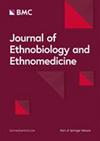Traditional lore on the healing effects of therapeutic plants used by the local communities around Simien Mountains National Park, northwestern Ethiopia
IF 2.9
2区 医学
Q1 BIODIVERSITY CONSERVATION
引用次数: 0
Abstract
Simien Mountain National Park is a world heritage site with spectacular landscapes and rich in floral diversity. Exploring the plethora of conventional wisdom regarding therapeutic flora for sustainable use and drug development is a timely endeavor. Thus, the present study was aimed at investigating therapeutic plant uses and conservation practices by the local communities dwelling in the vicinity of the Park. Eighty randomly selected general informants and 20 purposefully selected key informants were used to collect the traditional lore from 10 purposefully selected kebeles that border the Park. Data were collected using face-to-face interviews, guided field walks, group discussions and market surveys. Descriptive statistics were used to analyze the basic information collected from the informants. An independent sample t test was computed to compare the knowledge variations among different informant groups. Clustering and ranking techniques were employed to validate traditional wisdom of informants. Significant differences in traditional wisdom (P < 0.05) were observed only between general and key informants. Hundred thirteen therapeutic plant species belonging to 56 families were recorded. Asteraceae was the most species-rich family (10%). The majority of therapeutic species were collected from the wild (77%). Herbs and roots were the most preferred habit (47%) and plant parts (37%) for remedy preparation, respectively. Pounding was the most common preparation method (50.1%). The most frequently practiced route of administration was the oral route (48.1%). The highest Informant Consensus Factor (ICF) value (84%) was recorded for respiratory and febrile illnesses. Rumex nepalensis was the most preferred for the treatment of wounds, and Olea europaea subsp cuspidata was the first-ranked multipurpose plant. The Park is rich in therapeutic species serving as a refuge for many endemic and endangered species associated with the local community rich medicinal traditional lore. Erosion of therapeutic plants, verbal transfer of the traditional wisdom and young generation negligence in acquiring traditional lore led to the deterioration of the long tradition of using therapeutic plants for health care. Endangered multipurpose therapeutic plants like Echinops kebericho should get conservation priority. Therapeutic plants with the highest ICF and fidelity level could be candidates for drug development.关于埃塞俄比亚西北部西眠山国家公园周围当地社区使用的治疗植物疗效的传统传说
西眠山国家公园是世界遗产,拥有壮观的景观和丰富的花卉多样性。探索有关治疗植物区系的大量传统智慧以促进可持续利用和药物开发是一项及时的工作。因此,本研究旨在调查居住在公园附近的当地社区对治疗植物的使用和保护做法。研究人员随机抽取了 80 名一般信息提供者和 20 名特意挑选的关键信息提供者,从与公园接壤的 10 个特意挑选的村落收集传统传说。收集数据的方法包括面对面访谈、有指导的实地考察、小组讨论和市场调查。描述性统计用于分析从信息提供者那里收集到的基本信息。通过独立样本 t 检验来比较不同信息提供者群体之间的知识差异。采用聚类和排序技术来验证信息提供者的传统智慧。仅在一般信息提供者和关键信息提供者之间观察到传统智慧的显著差异(P < 0.05)。记录了隶属于 56 个科的 113 种治疗植物。菊科是物种最丰富的科(10%)。大多数治疗植物物种都是从野外采集的(77%)。草药和根分别是配制药方时最常用的习性(47%)和植物部分(37%)。捣碎是最常见的配制方法(50.1%)。最常用的给药途径是口服(48.1%)。呼吸道疾病和发热性疾病的线民共识因子(ICF)值最高(84%)。治疗伤口的首选植物是尼泊尔鲁梅克斯(Rumex nepalensis),而油橄榄亚种(Olea europaea subsp cuspidata)则是排名第一的多用途植物。该公园拥有丰富的治疗物种,是许多特有和濒危物种的庇护所,这些物种与当地社区丰富的医药传统传说息息相关。食疗植物的侵蚀、传统智慧的口头传承以及年轻一代对传统知识的疏忽,导致利用食疗植物进行保健的悠久传统日渐衰落。像 Echinops kebericho 这样的濒危多用途食疗植物应得到优先保护。ICF 和保真度最高的食疗植物可作为药物开发的候选对象。
本文章由计算机程序翻译,如有差异,请以英文原文为准。
求助全文
约1分钟内获得全文
求助全文
来源期刊

Journal of Ethnobiology and Ethnomedicine
PHARMACOLOGY & PHARMACY-
CiteScore
7.30
自引率
16.70%
发文量
66
审稿时长
>12 weeks
期刊介绍:
Journal of Ethnobiology and Ethnomedicine publishes original research focusing on cultural perceptions of nature and of human and animal health. Journal of Ethnobiology and Ethnomedicine invites research articles, reviews and commentaries concerning the investigations of the inextricable links between human societies and nature, food, and health. Specifically, the journal covers the following topics: ethnobotany, ethnomycology, ethnozoology, ethnoecology (including ethnopedology), ethnogastronomy, ethnomedicine, ethnoveterinary, as well as all related areas in environmental, nutritional, and medical anthropology.
Research focusing on the implications that the inclusion of humanistic, cultural, and social dimensions have in understanding the biological word is also welcome, as well as its potential projections in public health-centred, nutritional, and environmental policies.
 求助内容:
求助内容: 应助结果提醒方式:
应助结果提醒方式:


